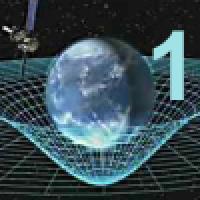
Plus Advent Calendar Door #1: Our changing picture of gravity
On the first day of advent we scroll through how our understanding of gravity has changed over the centuries...
When commander David Scott performed the last Moon walk of the Apollo 15 mission he took with him two objects you wouldn't normally think to bring into space: in one hand he held a feather and in the other a hammer. When he let the two objects drop they fell towards the surface of the Moon — and landed at exactly the same time.
With this experiment Scott confirmed a rather counter-intuitive prediction Galileo Galilei had made nearly 400 years earlier: that gravity causes all objects to fall to the ground with the same acceleration, no matter how heavy they are. The reason we don't usually see this effect on Earth is that air resistance interferes with the objects' fall. The Moon's atmosphere is much thinner than the Earth's, which is why Scott was able to demonstrate Galileo's prediction.
About a hundred years after Galilei's musings about gravity Isaac Newton revolutionised our understanding of it further, reportedly while he was sitting under an apple tree. Newton realised that the force that draws an apple to the Earth and the force that keeps the Moon in its orbit around the Earth, or the planets in their orbits around the Sun, are one and the same thing. He thus came up with his universal law of gravitation, which states that any two objects exert a gravitational pull on each other, which is described in terms of their masses, their distance and the gravitational constant. Gravity, then, is a truly universal feature of the Universe and all objects inside it.
Newton's theory of gravity works very well in everyday situations and even in not-so-everyday situations: to fly to the Moon, for example, it is all the physics you need. When Albert Einstein started thinking about gravity, however, he encountered a problem. According to Newton, gravity is a force that acts instantaneously across long distances, but Einstein's special theory of relativity, asserts that nothing, not even a force such as gravity, should be able to travel faster than light.

Gravity is the manifestation of the curvature of space and time. Image courtesy NASA.
After many years of hard work was Einstein developed a completely new framework: his famous general theory of relativity (GR). He had taken inspiration from Galileo's insight that near Earth gravity affects all objects in the same way. If this was the case, then perhaps gravity was not a feature of the actual objects, but a feature of spacetime. General relativity asserts that massive objects like the Earth or Sun don't emit a gravitational pull, but instead bend the very fabric of spacetime. This bending changes the way objects move as they travel through the curved spacetime: smaller objects are drawn towards massive objects, in some cases falling into orbit around them, or crashing into them.
Einstein revolutionised our understanding of gravity – but what were the repercussions of this new theory? What impact did it have on our understanding of the Universe? Find out the answers to this, and more, in the full article Our changing picture of gravity.
This year's advent calendar was inspired by our work on the documentary series, Universe Unravelled, which explores the work done by researchers at the Stephen Hawking Centre for Theoretical Cosmology and is available on discovery+. Return to the 2020 Plus Advent Calendar.